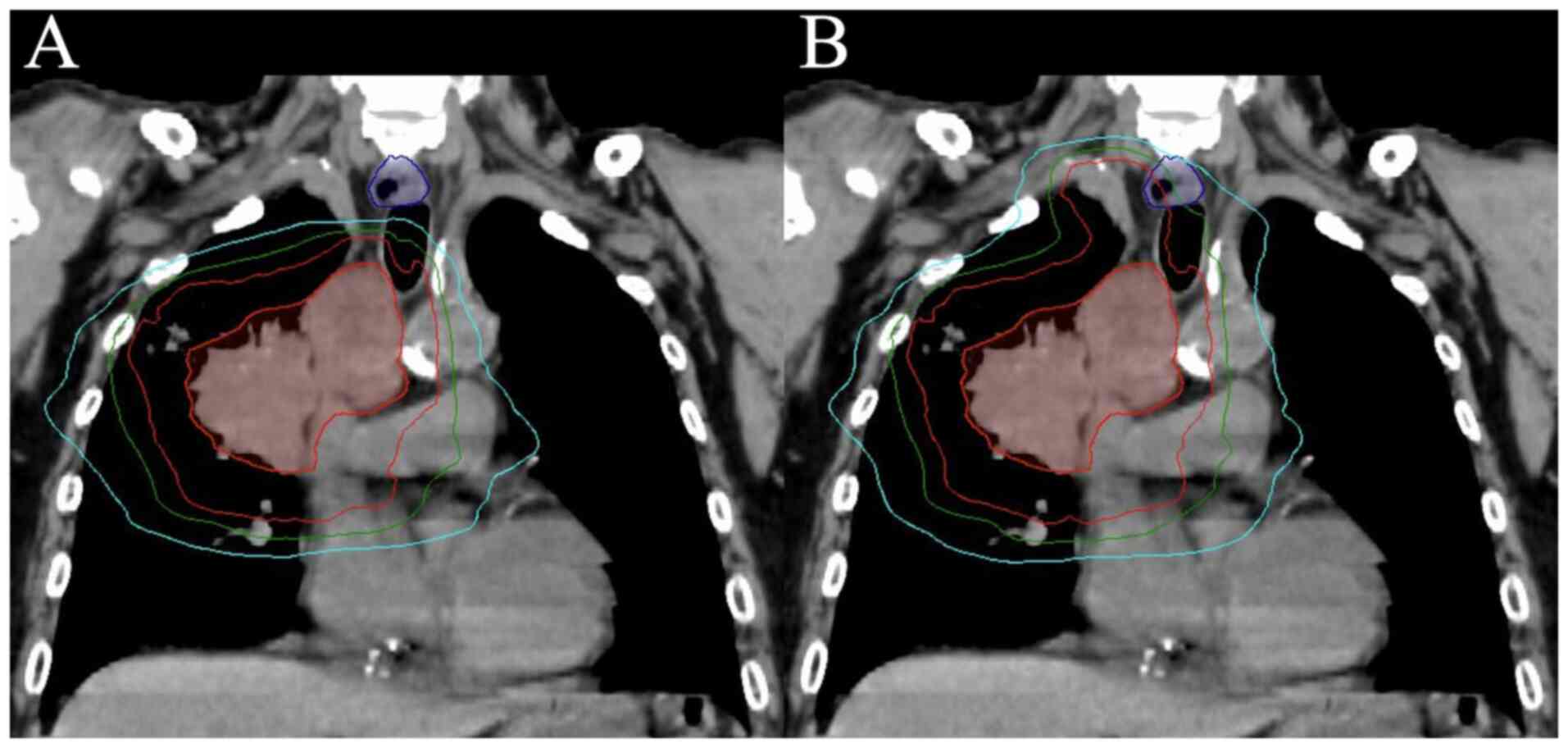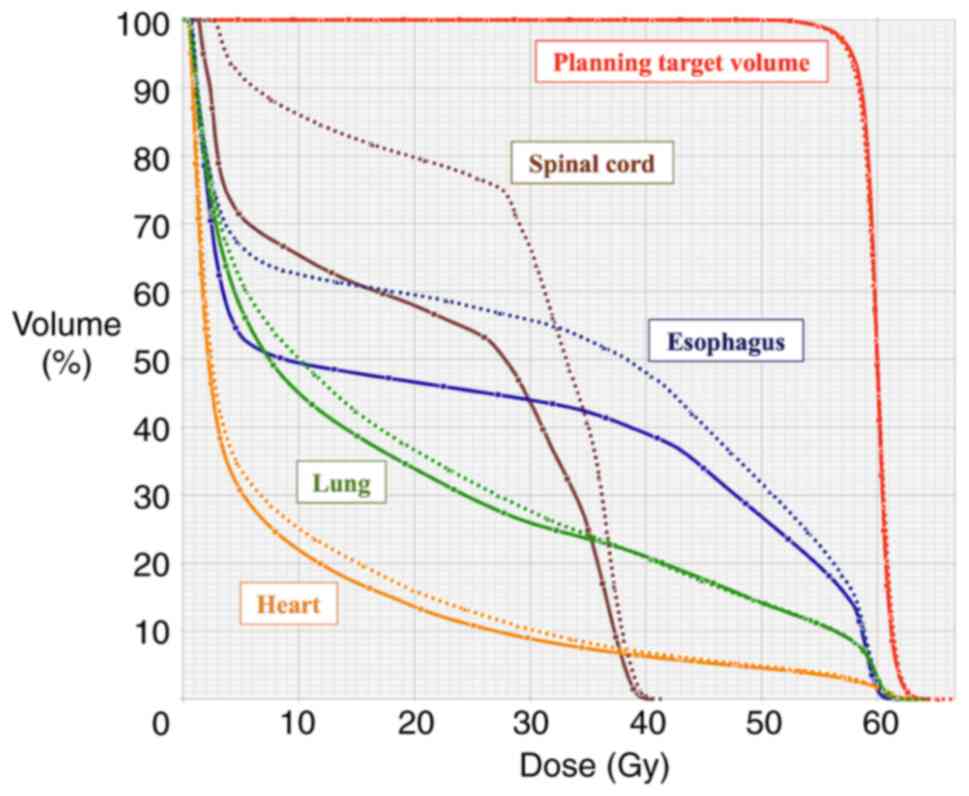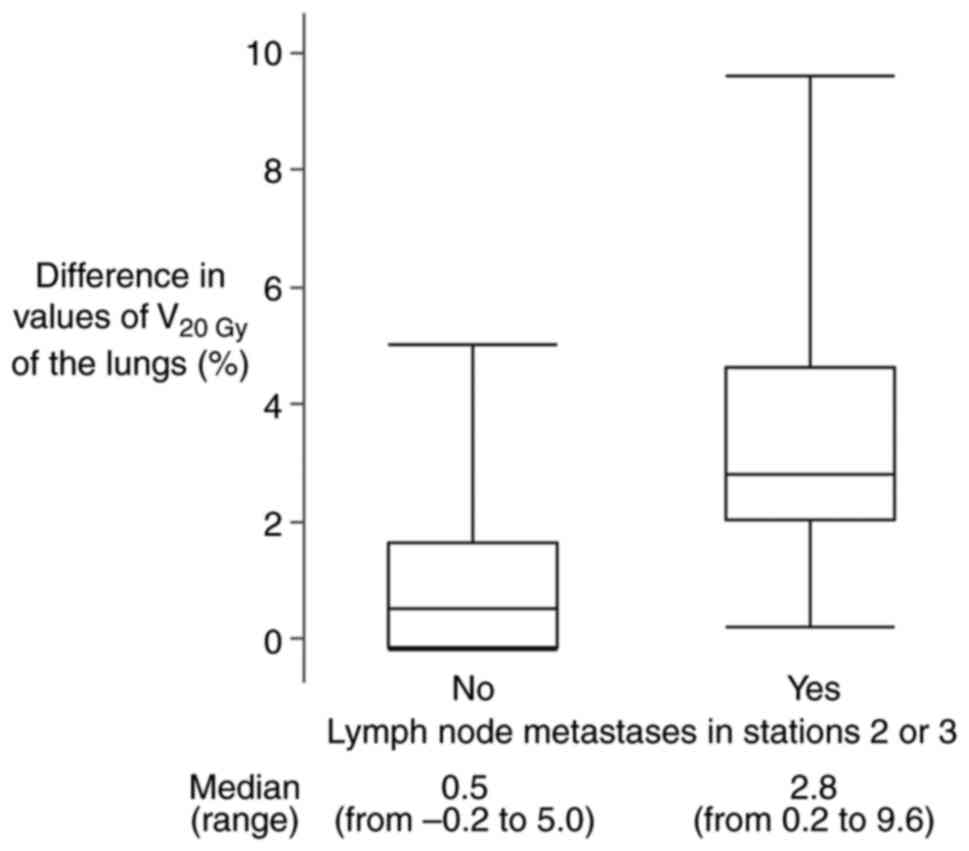Dosimetric comparison of nodal clinical target volume for locally advanced non‑small cell lung cancer: Options for geometric expansion vs. lymph node stations
- Authors:
- Published online on: June 26, 2024 https://doi.org/10.3892/mco.2024.2755
- Article Number: 57
-
Copyright: © Takahashi et al. This is an open access article distributed under the terms of Creative Commons Attribution License.
Abstract
Introduction
Lung cancer was the leading cause of globally cancer death (1). The incidence rate of non-small cell lung cancer (NSCLC) was about 85% of lung cancers (2). NSCLC was a heterogeneous disease invading the lung and adjacent tissues, eventually progressing and spreading to distant sites (3). A computed tomographic (CT) scan and a positron emission tomographic scan using 18F-fluorodeoxyglucose was used for the staging of NSCLC (3,4). Whilst chances for a complete remission or a cure were highest in early-stage cancers, survival rates decreased when the cancer was locally advanced (3,5). Proper treatment of locally advanced NSCLC can result in a cure or long-term survival (3). A locally advanced lung tumor was resectable if surgery was sufficient to achieve complete tumor removal and if the patient was able to tolerate the surgery (3). For patients with unresectable locally advanced NSCLC who were medically or surgically inoperable, chemoradiotherapy (CRT) was recommended (6). Typically, the unresectable patients were managed with concurrent CRT using a platinum-based doublet with a standard radiation dose of 60 Gy (7-9). After the initial treatment, patients without disease progression were treated by consolidation durvalumab (7,10). Patients who were likely to undergo radiation therapy (RT) should be assessed for the risk of lung toxicity secondary to radiation (3,11). The mean lung dose and the volume of healthy lungs receiving ≥20 Gy radiation doses were good indicators of the risk of radiation-induced lung injury (3,11). For the treatment planning of RT, selective nodal irradiation was recommended (12). From the European Society for Radiotherapy and Oncology (ESTRO) guideline, two options were recommended for the definition of nodal clinical target volume (CTV): (a) geometric expansion, with CTV including the nodal gross tumor volume (GTV) plus 5 mm margin, and (b) lymph node (LN) stations, with CTV including the affected LN stations (13). Conventionally, the option for geometric expansion was known as involved-field irradiation (IFI). It was expected that CTVs using the option of LN stations were larger than those with the other option because LN stations were frequently wider than the 5 mm margin from GTVs (14). However, it was unclear which option was more advantageous for reducing the normal tissue dose to avoid radiation toxicities.
Therefore, we retrospectively evaluated whether dosimetric differences existed in the nodal CTV using the two options for locally advanced NSCLC.
Patients and methods
Type of study
This single-institutional study was retrospectively conducted at our hospital. This study was carried out in accordance with the Declaration of Helsinki. Our institutional review board (The Research Ethics Committee of Kagawa University Faculty of Medicine, Kagawa, Japan) approved this study (approval number: 2022-165). After the approval, we investigated the patients who were treated at our hospital between 2017 and 2022.
Patients
The inclusion criteria of this study were as follows: patients over 20 years old; patients who had locally advanced NSCLC with cT4N2M0(15); patients who underwent RT; and patients who were treated between 2017 and 2022 at our department. The exclusion criteria were as follows: patients who refused to participate in this study. Written informed consent was obtained from each patient before treatment planning. The patient consent for publication in written form was obtained regarding the anonymized CT images in Fig. 1. In total, 17 patients met the selection criteria without refusal, and we used their treatment planning CT images for this study.
Treatment planning
A radiation treatment planning system (Eclipse™ v16; Varian Medical Systems) was used. We contoured nodal CTVs based on the ESTRO guideline's options of: (a) geometric expansion, with CTV including the nodal GTV plus 5 mm margin, and (b) LN stations, with CTV including the affected LN stations (13). The 5 mm margins for planning target volume (PTV) were added to the nodal and primary tumors' CTVs. Treatment planning of 60 Gy in 30 fractions to the PTV D50% was performed using volumetric modulated arc therapy; Dn% was the irradiated dose to n% of volumes of the structure; Dncc was the irradiated dose received by the highest irradiated n cc volumes of the structure; Dmean was the mean irradiated dose to the structure; VnGy was the percentage of volumes of the structure at least irradiated n Gy. Our goals of normal tissue dose constraints were as follows: D0.1cc of the spinal cord, ≤45 Gy; V20Gy, V5Gy, and Dmean of the lungs, ≤40%, ≤65%, and ≤20 Gy, respectively; V60Gy and Dmean of the esophagus, ≤17% and ≤34 Gy, respectively; V50Gy and Dmean of the heart, ≤25% and ≤20 Gy, respectively. Examples of the dose distribution and the dose-volume histogram (DVH) are shown in Figs. 1 and 2, respectively.
Statistical analysis
We compared DVH parameters between the two options using the Wilcoxon signed-rank test. V20Gy of the lungs was the most common DVH parameter for NSCLC (11). We evaluated the difference of V20Gy of the lungs between the two options in patients with or without LN metastases in stations 2 or 3 because stations 2 or 3 were wider for cranial-caudal direction than other stations (14). For the difference of V20Gy of the lungs between the two options, patients with and without LN metastases in these stations were analyzed as separate groups using the Wilcoxon rank sum test. Statistical significance was defined as P<0.05. The software program JMP Pro 15 (SAS Institute) was used for the statistical analyses.
Results
Patient characteristics are listed in Table I. Stations 2, 3, 4, 5, 6, 7, 10, and 11 were involved in 6, 4, 11, 4, 4, 7, 12, and 12 patients, respectively (Table II). The DVH parameters between the two options are listed in Table III, and the target coverage of PTV D95% was comparable between the two options. The normal tissue dose constraints of the spinal cord, lungs, esophagus, and heart were fulfilled in both options. The option of geometric expansion was associated with a significantly lower V60Gy and Dmean of the esophagus, V20Gy, V5Gy and Dmean of the lungs, and Dmean of the heart than the option of LN stations (P=0.017, P<0.001, P<0.001, P<0.001, P<0.001 and P=0.029, respectively).
For the V20Gy of the lungs, the eight patients (47%) with LN metastases in stations 2 or 3 had significantly larger difference values between the two options than the nine patients (53%) without those metastases (Fig. 3); median values of the difference were 2.8% (range, from 0.2 to 9.6%) and 0.5% (range, from -0.2 to 5.0%) with and without LN metastases in stations 2 or 3, respectively (P=0.027).
Discussion
In this study, we identified the merits of the option for geometric expansion to reduce the irradiated dose to the esophagus, lungs and heart in all patients with locally advanced NSCLC as compared with the option for LN stations. In daily clinical practice, if the dose constraints of the esophagus, lungs and heart were not fulfilled with the options for LN stations, we should try using the option for geometric expansion.
Esophagitis was one of the major toxicities after RT for locally advanced NSCLC. In a large phase 3 trial using CRT for locally advanced NSCLC, grades 2 and 3 esophagitis after a radiation dose of 60 Gy in 30 fractions occurred in 24% and 7% of patients, respectively (8). In long-term results of the trial, the maximum grade of esophagitis was one of the factors that affected overall survival (OS) on a multivariable analysis (9). Therefore, our finding might be important for prolonging OS through reducing the irradiated dose to the esophagus in all patients.
Pneumonitis was also one of the major adverse events after thoracic RT. As the V20Gy increased, the incidence rate of fatal pneumonitis rose in proportion in an international individual patient data meta-analysis: V20Gy <20%, 0.0% fatal rate; 20-29.99%, 1.0%; 30-39.99%, 2.9%, respectively (11). In the meta-analysis, the V20Gy was one of the predictors of fatal pneumonitis (11). Therefore, our finding might be important for avoiding fatal pneumonitis through reducing the irradiated dose to the lungs in all patients and especially in patients with LN metastases in stations 2 or 3. Stations 2 or 3 were wider for cranial-caudal direction than other stations (14). In stations 2 or 3, a 5 mm margin might be more advantageous to reduce the irradiated dose to the lungs than including the affected LN stations.
Recently, cardiac toxicities after RT for locally advanced NSCLC has been a topic. Pooled analysis of six prospective trials showed that the heart dose was associated with symptomatic cardiac events in multivariate analysis (16). The article concluded that heart doses should be minimized (16). Therefore, the present finding might be important for avoiding symptomatic cardiac events through reducing the irradiated dose to the heart in all patients.
To the best of our knowledge, no other study has compared the options for geometric expansion and LN stations, to date. For a somewhat modified comparison, a randomized phase 2 trial was conducted for no geometric expansion without CTV margins vs. LN stations (17). The trial showed that the option without CTV margins had significantly lower DVH parameters for the esophagus, lung, and heart than the option of LN stations (17). However, this CTV definition without margins was not mentioned in the ESTRO guideline (13). Therefore, it was difficult to compare the previous knowledge with our findings. Conventionally, the option for geometric expansion was known as IFI. Compared to elective nodal irradiation that irradiated mediastinal LN stations without LN metastases, IFI reduced the dose to the lungs and the incidence rate of pneumonitis (18). It was our new finding that IFI in all patients reduced the lung dose compared to the option of LN stations.
Due to its retrospective nature, our study has certain limitations, such as the small number of samples analyzed and its single-institutional design. A multi-center study was preferable to a single-center study to enhance the reliability and generalizability of our findings.
In conclusion, using the option for geometric expansion might help reduce the V60Gy and Dmean of the esophagus, V20Gy, V5Gy and Dmean of the lungs, and Dmean of the heart in all patients, and the V20Gy of the lungs in patients with LN metastases in stations 2 or 3. A further large-scale study is needed to support our findings. Moreover, further research is necessary whether the option for geometric expansion reduces the incidence of esophagitis, pneumonitis and symptomatic cardiac events compared with the option for LN stations.
Acknowledgements
This abstract was presented at the 65th Annual Meeting of the American Society for Radiation Oncology (San Diego, CA, USA; October 1-4, 2023), and was published as Abstract no. 2136.
Funding
Funding: The present study was supported by JSPS KAKENHI (grant no. JP20K16790).
Availability of data and materials
The data generated in the present study are not publicly available due to the restricted permission for the current study by the institutional review board (Research Ethics Committee of Kagawa University Faculty of Medicine, Kagawa, Japan) but may be requested from the corresponding author.
Authors' contributions
ST conceived and designed the study. ST, MA, TK and TN acquired data. ST and MA confirmed the authenticity of all the raw data. ST analyzed the data. ST, MA, TK, TN and TS interpreted the data. ST drafted the manuscript. Article revision was critically done by all authors. All authors read and approved the final manuscript.
Ethics approval and consent to participate
The Research Ethics Committee of Kagawa University Faculty of Medicine (Kagawa, Japan) approved the present retrospective study (approval no. 2022-165). Written informed consent for participation was obtained before treatment planning.
Patient consent for publication
Written patient consent for publication was obtained for the anonymized CT images.
Competing interests
The authors declare that they have no competing interests.
References
|
Bray F, Laversanne M, Sung H, Ferlay J, Siegel RL, Soerjomataram I and Jemal A: Global cancer statistics 2022: GLOBOCAN estimates of incidence and mortality worldwide for 36 cancers in 185 countries. CA Cancer J Clin. 74:229–263. 2024.PubMed/NCBI View Article : Google Scholar | |
|
Kinoshita FL, Ito Y and Nakayama T: Trends in lung cancer incidence rates by histological type in 1975-2008: A population-based study in Osaka, Japan. J Epidemiol. 26:579–586. 2016.PubMed/NCBI View Article : Google Scholar | |
|
Aoun-Bacha Z, Bitar N, Saleh WA, Assi H, Bahous J, Boukhalil P, Chami H, Dabar G, El Karak F, Farhat F, et al: Diagnosis and management of patients with stage III non-small cell lung cancer: A joint statement by the Lebanese Society of Medical Oncology and the Lebanese Pulmonary Society (Review). Oncol Lett. 25(113)2023.PubMed/NCBI View Article : Google Scholar | |
|
Covington MF, Koppula BR, Fine GC, Salem AE, Wiggins RH, Hoffman JM and Morton KA: PET-CT in Clinical Adult Oncology: II. Primary Thoracic and Breast Malignancies. Cancers (Basel). 14(2689)2022.PubMed/NCBI View Article : Google Scholar | |
|
Balata H, Fong KM, Hendriks LE, Lam S, Ostroff JS, Peled N, Wu N and Aggarwal C: Prevention and early detection for NSCLC: Advances in thoracic oncology 2018. J Thorac Oncol. 14:1513–1527. 2019.PubMed/NCBI View Article : Google Scholar | |
|
Daly ME, Singh N, Ismaila N, Antonoff MB, Arenberg DA, Bradley J, David E, Detterbeck F, Früh M, Gubens MA, et al: Management of Stage III Non-Small-Cell Lung Cancer: ASCO Guideline. J Clin Oncol. 40:1356–1384. 2022.PubMed/NCBI View Article : Google Scholar | |
|
Simone CB II, Bradley J, Chen AB, Daly ME, Louie AV, Robinson CG, Videtic GMM and Rodrigues G: ASTRO radiation therapy summary of the ASCO guideline on management of stage III non-small cell lung cancer. Pract Radiat Oncol. 13:195–202. 2023.PubMed/NCBI View Article : Google Scholar | |
|
Bradley JD, Paulus R, Komaki R, Masters G, Blumenschein G, Schild S, Bogart J, Hu C, Forster K, Magliocco A, et al: Standard-dose versus high-dose conformal radiotherapy with concurrent and consolidation carboplatin plus paclitaxel with or without cetuximab for patients with stage IIIA or IIIB non-small-cell lung cancer (RTOG 0617): A randomised, two-by-two factorial phase 3 study. Lancet Oncol. 16:187–199. 2015.PubMed/NCBI View Article : Google Scholar | |
|
Bradley JD, Hu C, Komaki RR, Masters GA, Blumenschein GR, Schild SE, Bogart JA, Forster KM, Magliocco AM, Kavadi VS, et al: Long-Term Results of NRG Oncology RTOG 0617: Standard-versus high-dose chemoradiotherapy with or without cetuximab for unresectable stage III non-small-cell lung cancer. J Clin Oncol. 38:706–714. 2020.PubMed/NCBI View Article : Google Scholar | |
|
Spigel DR, Faivre-Finn C, Gray JE, Vicente D, Planchard D, Paz-Ares L, Vansteenkiste JF, Garassino MC, Hui R, Quantin X, et al: Five-Year survival outcomes from the PACIFIC Trial: Durvalumab after chemoradiotherapy in stage III Non-Small-Cell Lung Cancer. J Clin Oncol. 40:1301–1311. 2022.PubMed/NCBI View Article : Google Scholar | |
|
Palma DA, Senan S, Tsujino K, Barriger RB, Rengan R, Moreno M, Bradley JD, Kim TH, Ramella S, Marks LB, et al: Predicting radiation pneumonitis after chemoradiation therapy for lung cancer: An international individual patient data meta-analysis. Int J Radiat Oncol Biol Phys. 85:444–450. 2013.PubMed/NCBI View Article : Google Scholar | |
|
De Ruysscher D, Faivre-Finn C, Moeller D, Nestle U, Hurkmans CW, Le Péchoux C, Belderbos J, Guckenberger M and Senan S: Lung Group and the Radiation Oncology Group of the European Organization for Research and Treatment of Cancer (EORTC). European Organization for Research and Treatment of Cancer (EORTC) recommendations for planning and delivery of high-dose, high precision radiotherapy for lung cancer. Radiother Oncol. 124:1–10. 2017.PubMed/NCBI View Article : Google Scholar | |
|
Nestle U, De Ruysscher D, Ricardi U, Geets X, Belderbos J, Pöttgen C, Dziadiuszko R, Peeters S, Lievens Y, Hurkmans C, et al: ESTRO ACROP guidelines for target volume definition in the treatment of locally advanced non-small cell lung cancer. Radiother Oncol. 127:1–5. 2018.PubMed/NCBI View Article : Google Scholar | |
|
Itazawa T, Tamaki Y, Komiyama T, Nishimura Y, Nakayama Y, Ito H, Ohde Y, Kusumoto M, Sakai S, Suzuki K, et al: The Japan Lung Cancer Society-Japanese Society for Radiation Oncology consensus-based computed tomographic atlas for defining regional lymph node stations in radiotherapy for lung cancer. J Radiat Res. 58:86–105. 2017.PubMed/NCBI View Article : Google Scholar | |
|
Gospodarowicz MK, Wittekind C and Brierley JD (eds): Lung. In: TNM Classification of Malignant Tumours. 8th edition. Wiley-Blackwell, New Jersey, pp106-112, 2016. | |
|
Wang K, Eblan MJ, Deal AM, Lipner M, Zagar TM, Wang Y, Mavroidis P, Lee CB, Jensen BC, Rosenman JG, et al: Cardiac toxicity after radiotherapy for stage III non-small-cell lung cancer: Pooled analysis of dose-escalation trials delivering 70 to 90 gy. J Clin Oncol. 35:1387–1394. 2017.PubMed/NCBI View Article : Google Scholar | |
|
Cui T, Zhang A, Cui J, Chen L, Chen G, Dai H, Qin X, Li G and Sun J: Feasibility of omitting the clinical target volume under PET-CT guidance in unresectable stage III non-small-cell lung cancer: A phase II clinical trial. Radiother Oncol. 181(109505)2023.PubMed/NCBI View Article : Google Scholar | |
|
Yuan S, Sun X, Li M, Yu J, Ren R, Yu Y, Li J, Liu X, Wang R, Li B, et al: A randomized study of involved-field irradiation versus elective nodal irradiation in combination with concurrent chemotherapy for inoperable stage III nonsmall cell lung cancer. Am J Clin Oncol. 30:239–244. 2007.PubMed/NCBI View Article : Google Scholar |












